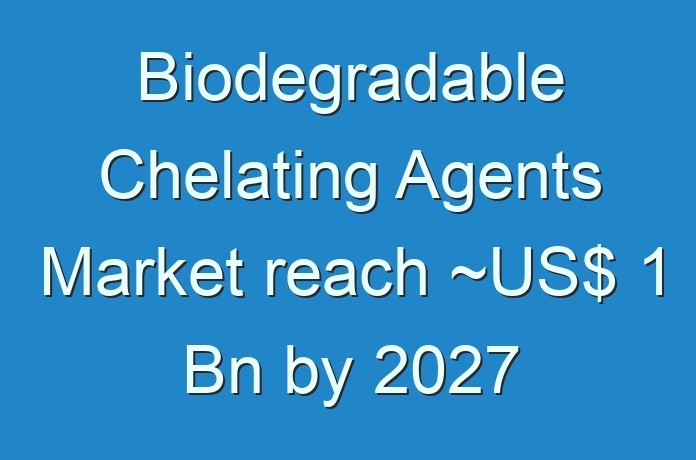
Biodegradable Chelating Agents Market: Introduction
In terms of value, the global biodegradable chelating agents market is anticipated to expand at a CAGR of 3% from 2019 to 2027 and reach ~US$ 1 Bn by 2027. Based on demand, Asia Pacific led the global biodegradable chelating agents market in 2018. This trend is anticipated to continue between 2019 and 2027. Of late, key industry stakeholders have been increasingly inclined toward more environmentally acceptable chelating agents that exhibit improved biodegradability profile, and are substitutes to the traditional aminopolycarboxylates. This trend is estimated to augment the demand for biodegradable chelating agents during the forecast period. Non-biodegradable traditional aminopolycarboxylates (APCA), such as EDTA, HEDP, and DTPA, pose considerable threats to the environment. Furthermore, they have been found to be toxic under laboratory circumstances, causing reproductive and developmental defects in animals. EDTA forms stronger metal complexes. As a result, it degrades slowly. Thus, it remains in the atmosphere. However, manufacturers prefer to use EDTA due to its easy availability. This, in turn, is projected to restrain the global biodegradable chelating agents market during the forecast period.
Biodegradable Chelating Agents Market: Prominent Product Chemistries
Gluconates is likely to be a prominent product chemistry of biodegradable chelating agents. Sodium gluconate is formed by the fermentation of glucose derived from corn. It is non-toxic and harmless to humans. Its bio-based nature makes the chemical biodegradable and environment-friendly. This has boosted its popularity for general usage. Citric acid has been widely used as a biodegradable chelating agent to provide an inexpensive alternative to APCAs. However, citric acid chelates feature a drawback: they are unstable at pH > 7.
Request PDF Brochure –
https://www.transparencymarketresearch.com/sample/sample.php?flag=B&rep_id=33605
Several companies produce biodegradable chelating agents, particularly for home and industrial cleaning applications. For instance, Dissolvine, the APCA biodegradable chelating agent brand provided by Nouryon, enhances the cleaning power of cleaners and detergents in household and institutional cleaning. It helps remove scale; soften the water; and boost the hygienic cleaning action. Thus, increase in usage of chelating agents for various cleaning applications is projected to create lucrative opportunities for the global biodegradable chelating agents market in the near future.
Biodegradable Chelating Agents Market: Major End-use Industries
Demand for biodegradable chelating agents is high in a wide range of applications. However, pulp & paper, water treatment, and home care segments played a key role in the global biodegradable chelating agents market in 2018. Together, these segments constituted more than 60% share of the global biodegradable chelating agents in terms of demand in 2018. Biodegradable chelating agents are widely used in water treatment applications in order to control and remove scale-forming calcium and magnesium in open circulating/cooling systems such as boilers, filter cloths, evaporators, glass-lined kettles, and heat exchangers.
REQUEST FOR COVID19 IMPACT ANALYSIS –
https://www.transparencymarketresearch.com/sample/sample.php?flag=covid19&rep_id=33605
Aminopolycarboxylate (APCA) biodegradable chelating agents are used extensively in several home care products and industrial cleaning processes. Biodegradable chelating agents prevent metals from interfering with the ability of a detergent to remove soil and stains from clothing. The demand for biodegradable chelating agents is expected to rise in the next few years, owing to the rise in consumption of paper. During the pulp manufacturing process, metals cause catalytic oxidation of hydrogen peroxide and ozone, which are common delignification chemicals used for production of mechanical and chemical pulp. In order to achieve this inactivation of metals, approximately 0.5–2 kilograms of chelating agents (in acid form) per ton of pulp are added. The demand for biodegradable chelating agents is anticipated to be high in the personal care industry in the near future. Biodegradable chelating agents are used to improve stability and enhance the effectiveness of personal care formulations such as shampoos, creams, bath preparations, oils, and ointments.
More Trending Reports by Transparency Market Research –
Asia Pacific to be Highly Lucrative Region of Biodegradable Chelating Agents Market
In terms of value, Asia Pacific held more than 30% share of the global biodegradable chelating agents market in 2018. Asia Pacific is a major region of the global biodegradable chelating agents market. Various companies engaged in wastewater treatment are focusing on expanding their business in Asia Pacific. In February 2018, Suez SA, a France-based water treatment company, announced plans to open a drinking water production plant in Indonesia. This is anticipated to drive the market in the region during the forecast period.
Competition Landscape of Biodegradable Chelating Agents Market
Major manufacturers of biodegradable chelating agents include Nouryon, Biesterfeld AG, ADM, BASF SE, Kemira, Cargill, Incorporated, and Jungbunzlauer Suisse AG. Of late, global manufacturers have made significant investments in the biodegradable chelating agents market. In July 2019, BASF SE launched Trilon M Max EcoBalanced, an advanced level of Trilon M Max. It is the first renewable-based product produced by using the biomass balance approach.





